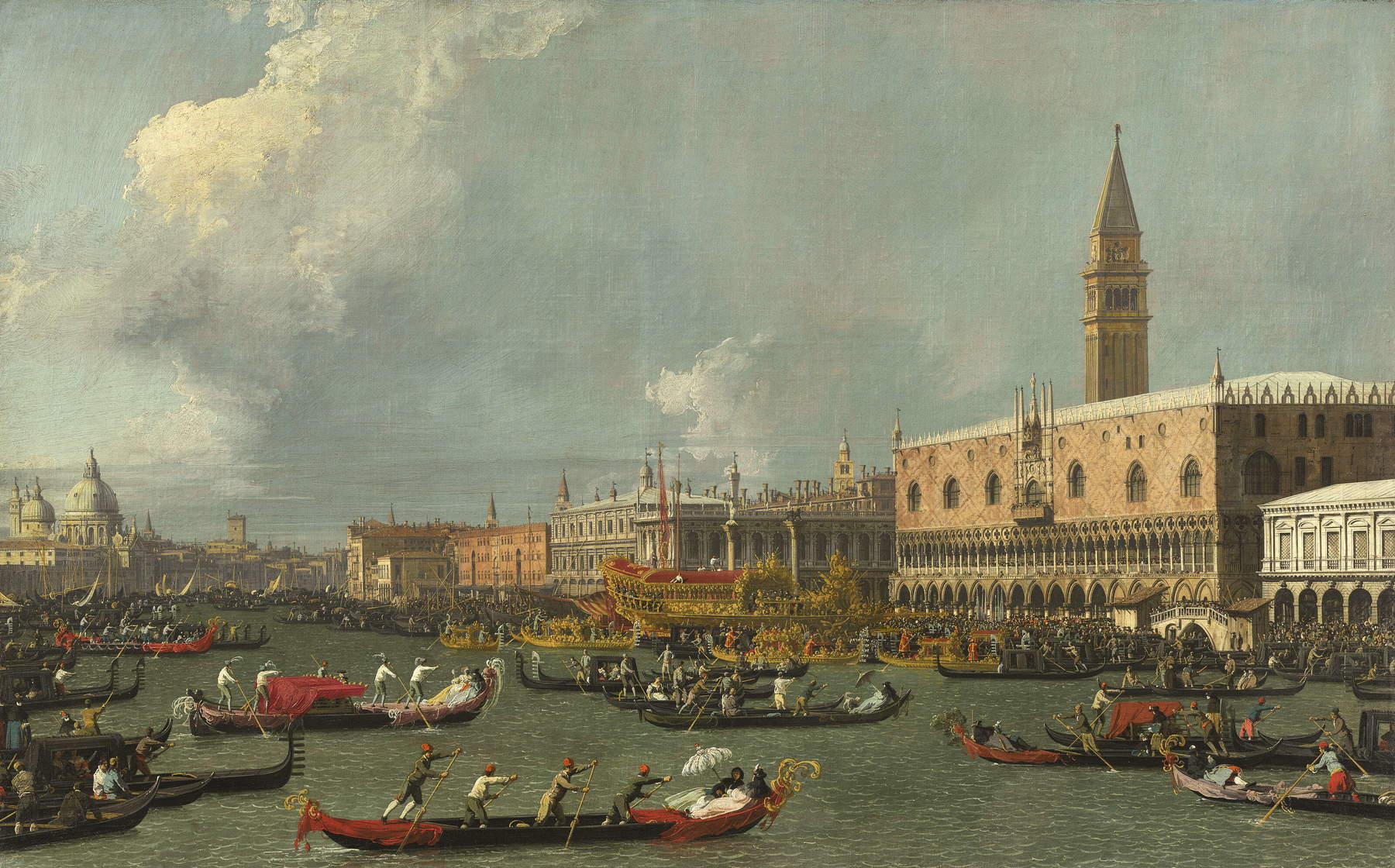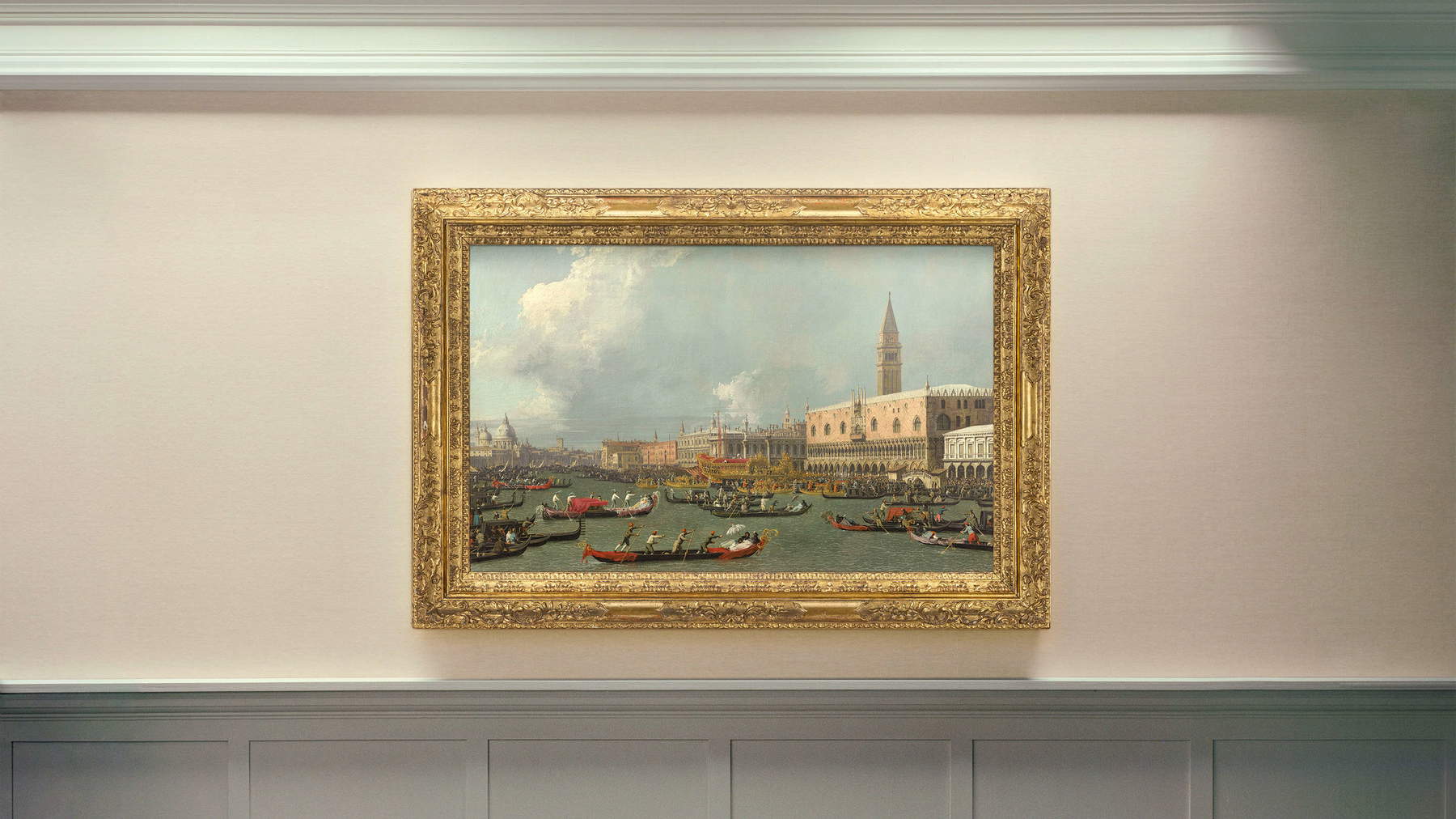The Canaletto painting that was going up for auction late this afternoon at Christie’s in London was sold for over £30 million. It was a masterpiece, for which there was great expectation: the work, The Return of the Bucintoro on Ascension Day, one of the cornerstones of Antonio Canal’s (Venice, 1697 - 1768) oeuvre omnia, started from an estimate of 20 million pounds. Of course, it is not known today who the buyer is, but it is not certain, as has happened with other big sales, that we will not find out in the coming days. The exact price: 31.935 million pounds, or about 37.2 million euros.
In more than 300 years, this work has gone to auction only twice, in 1751 and 1993. Some consider it the best work by Canaletto still in private hands. It is a painting that is in an exceptional state of preservation, thanks in part to the relatively few changes of ownership, though all of them very first-rate. The painting is first recorded in 1736 in a catalog of assets at 10 Downing Street, in the collection of Britain’s first prime minister, Sir Robert Walpole (1676-1745). This prestigious early 18th-century provenance has only recently come to light and was not known when the painting was sold in 1993: the circumstance, of course, affected the valuation. Canaletto painted the view in the early 1730s, a high point in the artist’s career and a period when his views were in high demand, especially among British collectors. Extremely ambitious in both size and conception, this is the first known depiction of the Bucintoro returning to the Molo on Ascension Day, a subject to which he would return repeatedly over the next two decades.

The Ascension was the most spectacular of all Venetian festivals and was often commented on by visitors and travelers who attended. It was only on this day that the Bucintoro, the official galley of the Doge of Venice and symbol of the Serenissima, was used. The model depicted in Canaletto’s painting, the last one made at the Arsenale, was designed by Stefano Conti and decorated by sculptor Antonio Corradini, identifiable by the lion-symbol of the city of Venice-on the prow and the figure of Justice. Accompanied by city officials, the doge would head to the Lido on the Bucintoro and throw a ring into the water, a symbolic act that represented the marriage of Venice to the sea. It was a ceremony that brought the entire city together and remained a key date in the Venetian calendar until the fall of the Republic in 1797. Given the popularity of Ascension Day among tourists in Venice, views of the occasion created by Canaletto were particularly in demand, and several interpretations of the celebrations by the artist are known, although these vary in viewpoint, scale, and characters.
St. Mark’s Basin, where the scene is set, was the usual-and certainly the most exciting-point of arrival-for visitors arriving in Venice by sea. This oblique panoramic view looks west toward the entrance to the Grand Canal, and the composition is framed by Punta della Dogana on the left and the Molo, in a sharply angled perspective, on the right. In the center is the Bucintoro, decorated in red and gold, moored among gondolas and other boats along the Piazzetta. The imposing buildings lining the banks provide the perfect backdrop for the pageantry and spectacle of Ascension Day, with the main monuments forming a theatrical backdrop for the lively boats and crew. Particularly prominent are the Doge’s Palace, with its unmistakable Gothic forms and distinctive facade decorated in pink Verona marble, and the imposing Campanile di San Marco behind it. The image is imbued with the warm hue of a summer day. The lagoon is populated with elegantly dressed figures lying in gondolas, the moored Bucintoro stands majestically in the background, and a crowd of onlookers gathers on the Molo in the distance.
Canaletto’s technique is extremely assured: controlled brush movements evoke feathery umbrellas and fluttering ribbons, vivid accents of color guide the viewer’s eye through the composition, with touches of vibrant red punctuating the entire composition. As Viola Pemberton-Pigott has observed, “despite the impression of color and luminosity in so many of Canaletto’s paintings, his range of pigments is remarkably limited.” Canaletto seems to have already mastered the formula for creating the effect of rippling water, with pale arcs leaping across the surface of the lagoon. He demonstrates a sure touch in depicting figures in motion, even those on different planes. The elegant protagonists in the gondolas are painted as individual characters, while the crowd gathered on the Pier pulses with life despite being painted in form. The figures in the foreground receive an almost three-dimensional structure through the application and manipulation of color itself, with Canaletto’s vivid use of impasto, moreover beautifully preserved. The artist demonstrates complete mastery of his medium and technique: as Pemberton-Pigott notes, Canaletto “learned to control the viscosity of the binder so that the color retains its shape and takes on the form it represents.” The scene as a whole has an airy, spontaneous quality, yet Canaletto’s technique is very precise. His architecture is meticulously constructed, with each building outlined and detailed with strict precision.
The Return of the Bucintoro on Ascension Day was in ancient times accompanied by a pendant depicting The Grand Canal Northeastward from Palazzo Balbi to the Rialto Bridge (now in a private collection). The two paintings share an important early history, having been owned by Britain’s first Prime Minister, the great patron and collector Sir Robert Walpole. Their presence in Walpole’s collection was first noticed by Sir Oliver Millar, who found them mentioned in the 1736 manuscript catalog of paintings at 10 Downing Street and in the 1751 auction sale. The Return of the Bucintoro on Ascension Day is to be identified with the first of the “Canalletti” exhibits “In the drawing room,” recorded under inventory number 125. It is, moreover, the first evidence of a Canaletto painting exhibited in a house in England, anticipating by a quarter of a century the purchase of the Canaletti from Consul Joseph Smith by George III.

The Downing Street residence was offered to Sir Robert Walpole by King George II in 1732, and has remained the residence of England’s prime minister ever since. British architect William Kent renovated the interiors of two adjacent properties and combined them to create a new complex of sixty rooms. Sir Robert and his wife settled there in 1735, remaining until Walpole left office in 1742, after which he took his collection of paintings to Houghton Hall in Norfolk. Sir Robert had begun collecting paintings in the 1720s, and his 1736 inventory lists 154 paintings at 10 Downing Street, 120 at Houghton, 78 at Orford House in the grounds of the Royal Hospital in Chelsea, and 66 in his five-bay townhouse at 16 Grosvenor Street in Mayfair, with his “Great Room” on the second floor where the paintings were displayed. It is not known how or when Sir Robert acquired this magnificent view and its pendant: it may have been through his son Edward, who was sent to Venice with the task of acquiring works of art between January 1730 and March 1731, although both views can be dated, for stylistic reasons, to around 1731-32 and, therefore, slightly later than Edward’s Venetian sojourn. Although no doubt facilitated by Edward’s acquaintances in Venice, the purchase of the paintings must nevertheless have been stimulated by the renovation of the Downing Street residence in 1732-35.
It is then likely that Sir Robert obtained the pair of paintings through banker and dealer Joseph Smith, himself a discerning collector, who was the intermediary in many and perhaps most of the commissions to Canaletto. Placed in plain view in his “official” residence at 10 Downing Street, the paintings must have been seen by many of Walpole’s associates. Moreover, many of Walpole’s leading associates, including the 2nd Duke of Richmond (who held the key position of Master of the Horse), the 3rd Duke of Devonshire (Lord of the Privy Seal) and the 2nd Duke of Argyll (Feld-Marshal) purchased paintings by Canaletto, as did Lord Lincoln, nephew and heir of the 1st Duke of Newcastle. For these men and many others, their Canalettos were not only perfect works of art and, in many cases, captivating reminders of their Grand Tours, but also seductive statements of the longevity of an aristocratic republic that balanced the visions and whimsy of ancient Rome, whose history and literature had been central to their education. Walpole’s two great views of Venice by Canaletto thus occupy an epicentral position in the patterns of taste and political attitudes in 18th-century England.
Canaletto’s views were later sold at auction by Sir Robert’s nephew George Walpole in 1751. It was probably purchased by Jones Raymond (1706-1769), director of the East India Company, engraver and amateur collector, on behalf of a certain “Gideon,” who may have been, in all likelihood, Samson Gideon (1699-1762), a celebrated Jewish financier who achieved notoriety and amassed a large personal fortune in the City of London. Gideon sought to use his great wealth to establish his family among the ranks of the British landed aristocracy and eventually secured the title of baronet for his son, Sampson. Canaletto’s paintings passed by descent to Sampson himself and, upon his death, to his only surviving heir, his daughter Maria.
The return of the Bucintoro on Ascension Day remained in private hands for nearly 200 years, passing from hand to hand among the family’s descendants from 1751 to 1930. It was bought later that year by the historic Agnew Gallery and sold ten years later to Giuseppe Bellesi, a Florentine art dealer based in London. Bellesi had founded the Italian Art Gallery in 1926, initially located on Savile Row, then moved to New Bond Street and finally to Duke Street. During World War II Bellesi returned to live in Italy, and upon his return to London in 1948 he reopened his gallery at 15 Paddington Green. It seems likely that Bellesi sold the painting to Mario Crespi, in whose collection both Canalettos were published in 1954. The eldest son of Benigno Crespi, Senator Mario Crespi was a prominent figure in early 20th-century Italy: when his father died in 1910, Mario and his two brothers in fact inherited a business empire that included the publishing group that controlled Corriere della Sera. In 1952 he moved with his wife to a palace on Via Sant’Andrea in Milan where, after extensive restoration, he would display his impressive collection of 18th-century Venetian paintings.
The Return of the Bucintoro was then allegedly purchased in Paris in the 1960s by a French collector, along with its pendant. The two paintings remained together until sold by Ader Tajan in 1993, where the painting fetched a record price for an Old Master at a French auction. The exceptional painterly quality, illustrious provenance, and outstanding condition of both paintings meant that when the pendant was sold in 2005, it sold for the highest price ever paid for a Canaletto: £18.6 million. A record that lasted 20 years. Until today.
 |
| Canaletto masterpiece sold at Christie's for £31 million |
Warning: the translation into English of the original Italian article was created using automatic tools. We undertake to review all articles, but we do not guarantee the total absence of inaccuracies in the translation due to the program. You can find the original by clicking on the ITA button. If you find any mistake,please contact us.